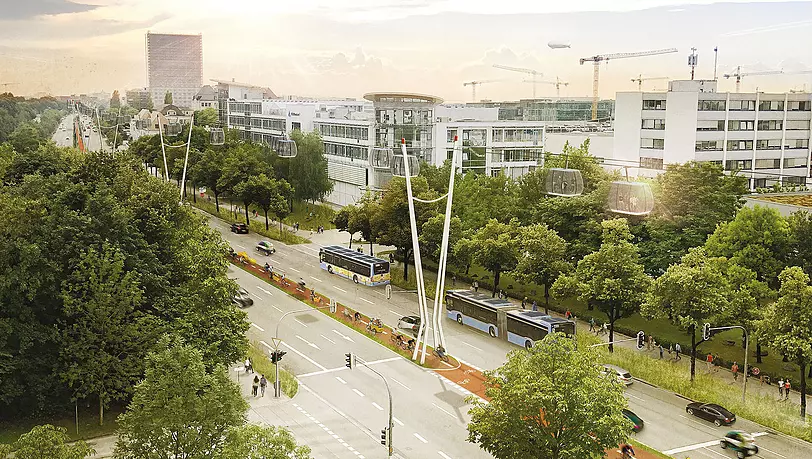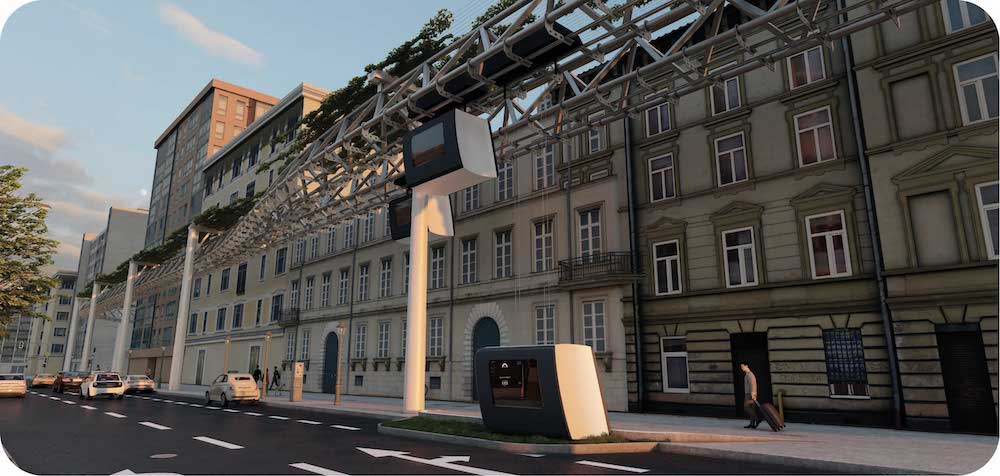Imagine you could have a public transportation system that is faster than a car, cheaper to build than a tram, and has the flexibility of a taxi. The Ottobahn promises to be all that. But can it really square the circle? In this article, we take a closer look at the concept proposed by the Munich-based startup of the same name.
The Ottobahn
Imagine you could call a cabin in a city to any place you want. It picks you up where you live and then transports you quickly and silently to your destination. It travels far above the ground and all traffic jams. There is no need to change trains, as the cabin is just for you and will take you directly to your destination. This is the concept of the “Ottobahn”, named after the Bavarian Duke “Otto” and the German word “Bahn”, which means railroad.

The Ottobahn is an elevated railway system, like the Wuppertal Suspension Railway. What is new about it is that it does not carry entire trains, but smaller capsules or “pods” that can carry up to 4 people. In the Ottobahn concept, these pods do not stop at fixed stations like a subway. Instead, they can stop anywhere along the line. The idea is that you can use your smartphone to summon one to your home. The pod will then navigate itself to the nearest location. It will be lowered to street level on long cables, and you will enter it comfortably, like a bus. Then the pod is raised and you can start your journey on the elevated tracks.

The pod will then navigate to your destination, automatically switching to other tracks as needed. There is no driver in the pod, everything is controlled by a computer.
At your destination, the process is reversed, and you can exit the pod and walk the rest of the way.
The Ottobahn also proposes the use of cargo pods that can carry loads of up to one ton.

The company has one test track inside the offices in Ottobrunn near Munich. It also has permission to build a full-size test track nearby, but this is not yet complete.
(The pictures in this section are taken from the company’s homepage.)
Is It Going to Work?
If you listen to the company, the Ottobahn is supposed to solve many of the traffic problems facing cities today: Congestion, bad air, too many cars making it hard for pedestrians to get around, high costs of other public transportation systems. But is this really possible? Let’s take a closer look.
Can it work as a mass transit system? I am skeptical about this, because at the same time it wants to be an individual transportation system. It uses small pods, each with a much smaller capacity, to allow each individual to reach their destination without changing. Individual pods traveling in sequence have to keep a minimum distance from each other, and because they travel on rails with less friction, they also need a larger minimum distance between trains. This means that the capacity of the system is likely to be lower than that of other rail-based systems such as subways and trams, which have larger trains.
Another factor that will further reduce capacity is that the pods can stop along the track to pick up passengers. While they are stopping, they are blocking other pods. This is a serious problem, and I don’t see how they can solve it without building a lot of extra tracks, which would increase construction costs even more. It would also limit the places where the pods could stop, which would break the promise of individual mobility a bit.
I also wonder where the space for the pods will come from when they are lowered to the ground to pick up passengers. Will it be taken from existing parking spaces? Or from the sidewalks? And where can the pods stop when the tracks are not on a sidewalk, but in the middle of a busy street?
Lowering the pods to the ground also raises the issue of safety. In the drawings provided by the company, the pods are lowered on a pair of cables. But what happens if one of the cables breaks? Unlike an elevator, there is no extra safety in this case. I am pretty sure that no regulator would allow such a system.
Overall, the concept of pods that can be lowered to street level does not really seem feasible to me, and I think the founders might revert to conventional stations at track level. Of course, this would make the construction much more expensive and take away one argument for the Ottobahn.
The system might also face acceptance problems from people living along the streets. Who would like to have pods in front of their windows, with passengers peering into their living rooms? This was a concern with the Wuppertal suspension railway (which was mostly built over rivers), and also with cable cars like the one once proposed for Munich.

The company’s homepage does not answer the question of how the switches are constructed. They claim to have a patented system. But the question of how to build efficient and safe turnouts for monorails – and the Ottobahn is a monorail – has not been adequately answered. Have the founders of the Ottobahn found the holy grail?
Another concern is that an elevated railway in a city needs many supports. How will they fit into the often complex landscapes of modern streets, with traffic lights, tramway overhead lines, and above all, bridges crossing the streets? Of course, this could be avoided by building a city or district from scratch, but such cases are rare, and brownfield projects are the norm.
Outlook
I find the idea of the Ottobahn quite fascinating. But looking behind all the glossy pictures, I miss the substance of a concept that tries to solve the problems you find when putting an idea into reality. Unfortunately, none of these details are explained on the company’s website, so I don’t know how they plan to overcome these problems.
Another thing that makes me unsure about the prospects of the concept is that the last news is from April 2023, so almost half a year old, and not even about the Ottobahn itself. The construction of the first test track seems to be far behind schedule as it was planned for 2022. Also, it is not clear which cities are planning to adopt this system, although the company touts that they have interested partners.
Right now, it looks like the Ottobahn is going to be another futuristic concept that fails to replace the existing transportation system. But I hope I am wrong, because the idea certainly looks fascinating.
